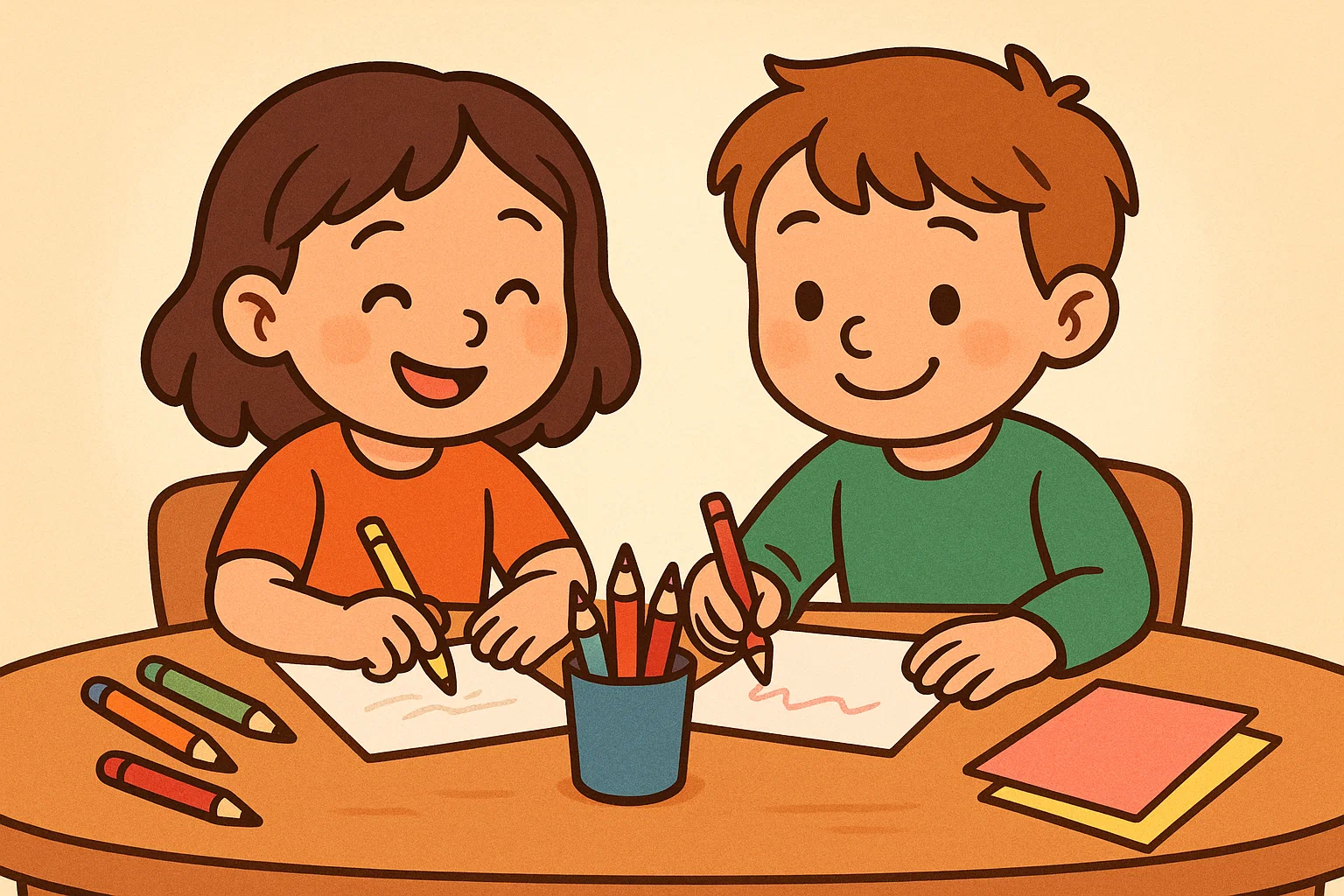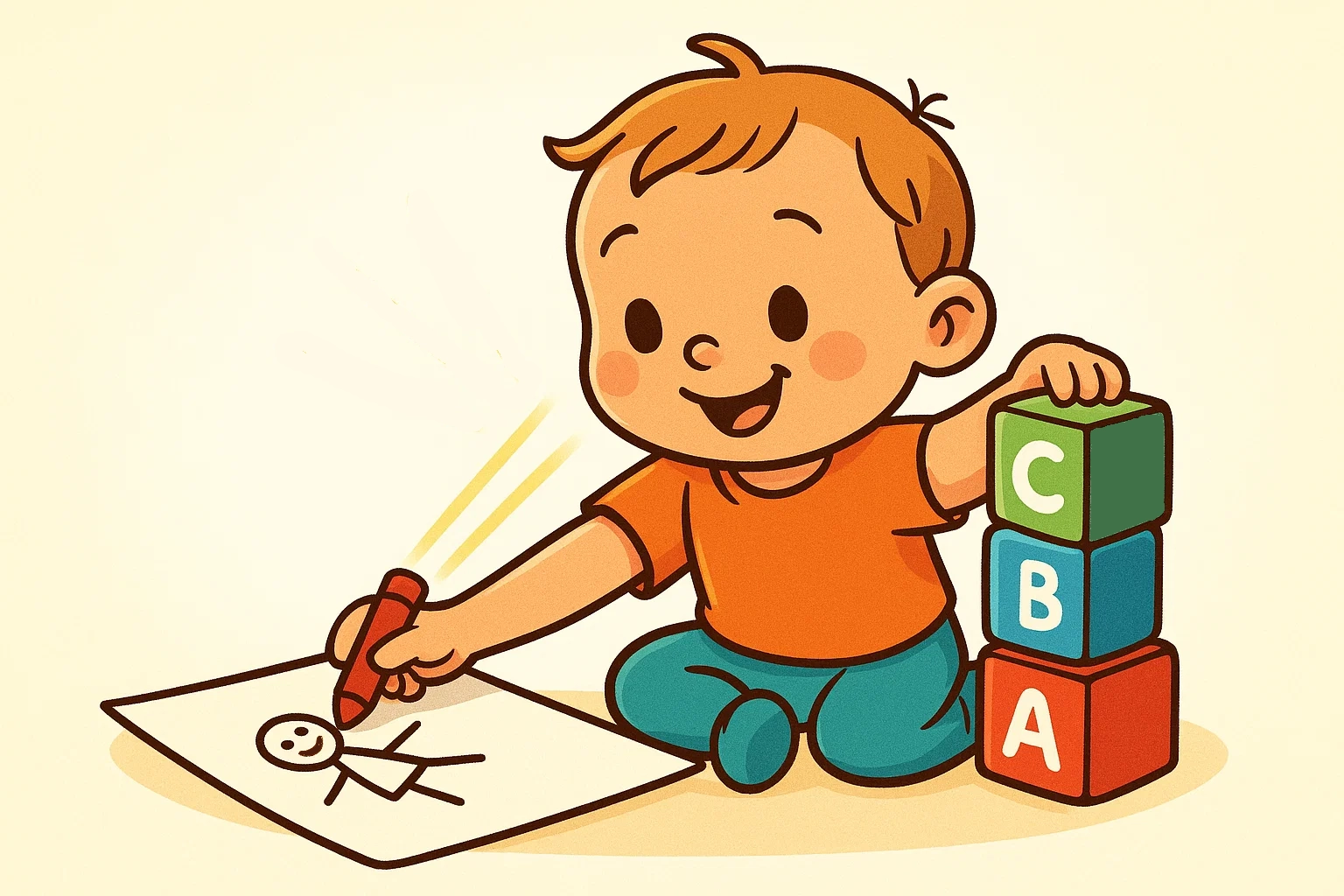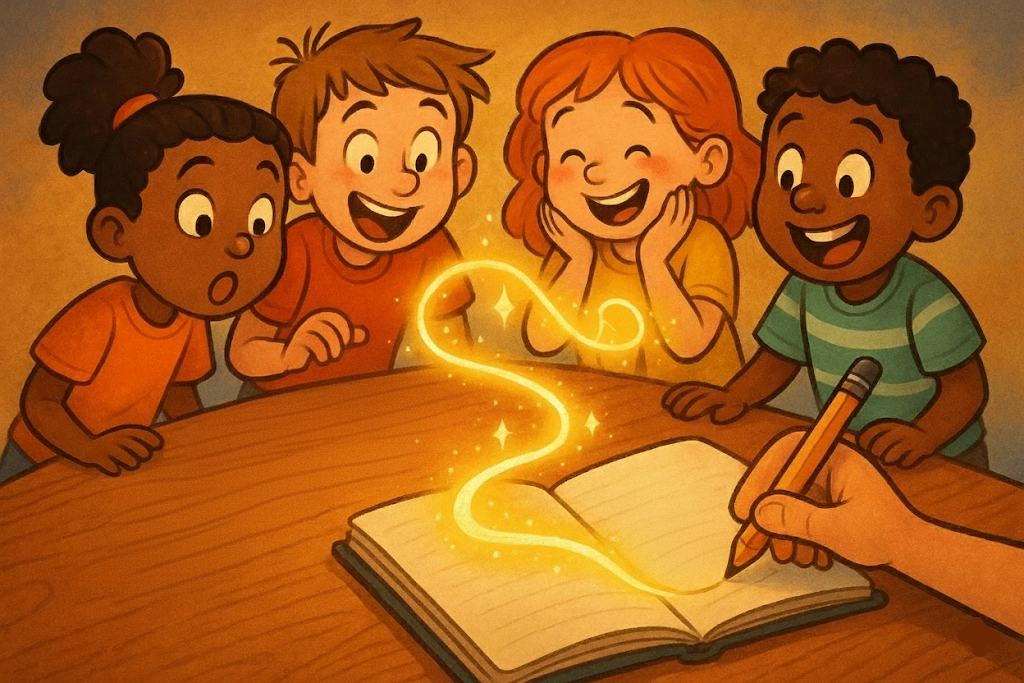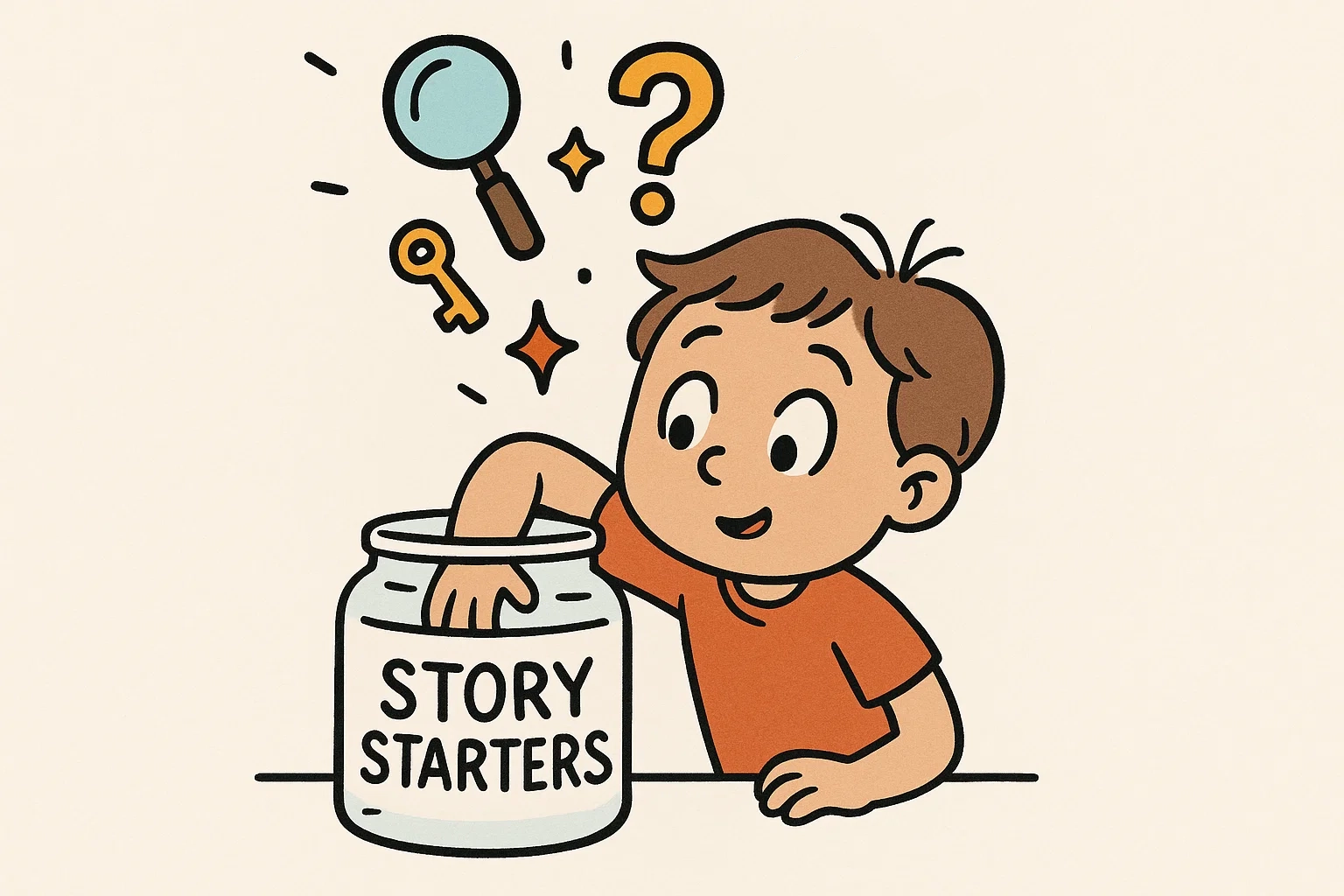Activities & Games to Get Kids Writing

When children engage with writing through play, something remarkable happens. The pressure disappears, creativity flows, and skills develop naturally. Writing games transform what many kids perceive as a challenging task into an adventure they actively seek out.These games create opportunities for kids to experiment with language, develop their unique voice, and build foundational literacy skills without the stress that traditional exercises sometimes bring.
Importance Early Writing Skills

Early writing development extends far beyond forming letters on paper. It shapes how children communicate, process information, and express their understanding of the world around them.
Benefits Holistic Skill Development
Writing games support multiple developmental areas simultaneously:
- They strengthen fine motor control while expanding vocabulary when kids play word-building games.
- Story creation activities enhance sequential thinking and problem-solving abilities.
- Even simple letter recognition games help develop visual discrimination skills that support reading comprehension later.
One study from the Journal Evaluation in Education examining elementary education found that students who engaged in game-based writing activities demonstrated higher creativity scores compared to those using only traditional methods. The multisensory approach helps children make stronger neural connections, leading to better retention and application of writing skills.
Motivation for Young Learners
Children naturally gravitate toward activities that feel rewarding. Writing games tap into intrinsic motivation by providing:
- Immediate feedback
- Celebrating small victories
- Allowing kids to see their progress in real-time
A child who struggles to write three sentences in a traditional assignment might enthusiastically create an entire story when it’s framed as a game with their friends or family. The competitive element (when age-appropriate) can drive engagement without creating excessive pressure. Kids learn that making mistakes is part of the fun, which reduces anxiety around writing tasks. This mindset shift proves invaluable as they encounter more complex writing assignments throughout their education.
Why Games Matter for Learning
Games create what educators call “low-stakes practice environments.” This psychological safety encourages risk-taking, which is essential for developing strong writing skills. Through repeated play, kids internalize:
- Grammar patterns
- Sentence structures
- Storytelling conventions organically
They learn by doing rather than memorizing rules, which leads to deeper understanding. The social aspect of many writing games also builds collaboration skills and exposes children to different perspectives and writing styles.
Less Stressful Learning Environment
Traditional writing instruction can sometimes create performance anxiety, especially for kids who find expressing themselves through words challenging. Writing games remove this pressure by:
- Focusing on the process rather than the product (There’s no red pen corrections or grades—just exploration and enjoyment).
- Associating writing with fun rather than evaluation, making children more likely to write voluntarily outside structured learning time.
This voluntary practice creates a positive feedback loop: more writing leads to better skills, which increases confidence and willingness to write even more.
Physical Sensory Games
Young children learn best when their whole body is involved. Physical and sensory writing games help preschoolers and kindergarteners develop pre-writing skills while burning energy and having fun.
Hands-On Writing Activities Squishy Bags
This activity builds finger strength and control necessary for holding pencils properly. The tactile feedback helps kinesthetic learners make stronger connections between the letter shape and its name. Children can practice the same letter multiple times by simply smoothing out the gel and starting fresh. The benefits of this activity include:
- Building finger strength and control necessary for holding pencils properly.
- Allowing children to practice the same letter multiple times by simply smoothing out the gel and starting fresh.
- Providing tactile feedback that helps kinesthetic learners make stronger connections between the letter shape and its name.
Variation: Add food coloring or glitter to the gel for extra visual interest. Hide small objects inside for kids to find while forming letters around them.
Disappearing Yarn Letters Name Pop
Give children pieces of colorful yarn to form letters on the floor or a table. They can spell their name, practice specific letters, or create simple words. The “disappearing” aspect comes when you challenge them to close their eyes and visualize the letters before opening them again. The “Name Pop” version adds excitement: write letters on balloons, then kids pop them in order to spell their name. This combines letter recognition with gross motor skills and provides an immediate reward (the satisfying pop) for each correct choice.
Alphabet Hopscotch Letter Dance
The setup and variations for this game include:
- Draw large letters or word family patterns on the sidewalk with chalk.
- Call out letters or sounds, and children hop to the correct space.
- Create word-building hopscotch where they jump to individual letters in sequence to spell simple words (for older kindergarteners).
- Add movement requirements like spinning or hopping on one foot to increase the challenge and engagement.
This game combines phonics practice with physical activity, helping kids who struggle to sit still during traditional writing time.
3D Drawing Glitter Glue Lines
Provide glitter glue, puffy paint, or thick craft glue for children to trace over letters printed on cardstock. Once dry, these raised letters create tactile learning tools. Kids can run their fingers over the bumpy texture, strengthening the sensory memory of each letter’s shape. This activity particularly benefits children who need multi-sensory input to learn effectively. The process of carefully following the letter outline with glue improves hand-eye coordination and introduces proper letter formation habits before pencil writing begins.
Creative Storytelling Narrative Games

Storytelling games help children understand narrative structure while encouraging imaginative thinking. These activities make the abstract concept of story creation tangible and accessible.
Story Cards Dice Roll-a-Story
Roll-a-Story uses dice labeled with these story elements:
- Characters (princess, astronaut, detective)
- Settings (castle, spaceship, city)
- Problems (lost key, broken machine)
- Solutions (teamwork, magic, invention)
Children roll the dice and construct stories based on what appears. This random element makes each round unpredictable and exciting. Create a set of cards with images, characters, settings, and situations. Kids draw 3-5 cards and must weave them into a coherent story. This structure provides enough guidance to prevent blank-page paralysis while leaving room for creativity.
Story Maps Plot Development Tools
Visual story maps help children understand how stories flow from beginning to middle to end. Draw a simple path or mountain shape, marking spots for:
- Introducing characters
- Presenting the problem
- Building tension
- Reaching the climax
- Resolving the story
As kids plan their stories on these maps, they develop organizational skills that transfer to longer writing projects. The visual representation makes abstract plotting concepts concrete, especially helpful for visual learners who struggle with linear outlining methods.
Accordion Stories Communal Story Write
Fold a long piece of paper accordion-style, creating multiple panels. Each family member or student writes one sentence or paragraph on a panel, folds it to hide their contribution, and passes it to the next person. The reveal at the end often produces hilarious results and teaches children about story coherence. This communal approach removes the pressure of creating a complete story alone. Children see how different writing styles can work together and learn from the vocabulary and sentence structures others use.
Keep Favorite Book Going Re-Write Ending
After reading a beloved story together, challenge kids to imagine what happens next or create an alternative ending. This game builds on their existing engagement with characters and settings while teaching them that stories are flexible, creative constructs they can manipulate. Some children find starting from scratch intimidating but feel confident working within an established story world. This bridge helps them transition from passive readers to active story creators, developing their unique voice while practicing writing mechanics.
Prompts Inspire Writing Creativity

Even enthusiastic young writers sometimes need a spark to get started. Prompt-based games provide that initial inspiration while building descriptive and imaginative writing skills.
Story Starters Jar Mystery Bag Descriptions
Fill a jar with interesting opening sentences: “The door creaked open to reveal…” or “Nobody expected the package to contain…” Children draw a slip and must continue the story for a set time or number of sentences. The element of chance makes it feel like a game rather than an assignment. Mystery Bag Descriptions use a similar approach with objects. Place an item in a bag without showing children what it is. They reach in, feel the object, and write descriptions or stories based on texture, shape, and weight before revealing what they touched. This enhances sensory description skills.
Pass-the-Picture Word Drawing Game
Start with a simple drawing, then pass it around the circle. Each person adds one element and writes a sentence explaining their addition. By the final round, you’ll have a collaborative story with an accompanying illustration. This game shows kids how details build upon each other to create rich narratives. It also demonstrates that writing is often a process of revision and addition rather than getting everything perfect on the first try.
Draw What You Hear Focus Details
Read a detailed description of a scene or character without showing any pictures. Children draw what they hear, then compare their illustrations. Discuss which descriptive words helped them visualize clearly and which left them confused. This teaches the importance of specific, clear writing. Reverse the game by having children write descriptions of their own drawings without showing them. Others attempt to recreate the image based solely on the written description. The comparison highlights the power of precise word choice and thorough details.
Scavenger Hunt Secret Letter
This activity transforms spelling practice into an active game that combines movement with literacy skills. You can hide the following items:
- Letter tiles
- Magnetic letters
- Paper letters
Children hunt for them, collecting letters to spell assigned words or create their own words. The “secret letter” variation challenges kids to find letters that spell a hidden message or answer a riddle. Each discovered letter brings them closer to solving the mystery, maintaining high engagement throughout the activity.
Literary Format Genre Games
Exposing children to different writing formats broadens their understanding of how words can be arranged and helps them discover their preferred forms of expression.
Play with Poetry Acrostic Limerick Haiku
Poetry games introduce rhyme, rhythm, and concise expression. Acrostic poems, where each line starts with a letter from a word written vertically, provide structure that supports reluctant writers. Kids can create acrostics of their names, favorite animals, or seasonal words. Limericks teach rhythm and humor through their distinctive five-line pattern. The silly nature of most limericks makes them appealing to children who enjoy wordplay. Haiku’s syllable-counting structure turns poetry into a puzzle-solving game while teaching observation and conciseness.
| Poetry Type | Structure | Best For |
| Acrostic | Vertical word with lines starting with each letter | Beginning poets, vocabulary building |
| Limerick | 5-line AABBA rhyme scheme | Humor, rhythm practice |
| Haiku | 5-7-5 syllable pattern | Observation skills, brevity |
| Concrete | Shape formed by arranged words | Visual learners, creativity |
Free Verse Simile Concrete Poem
Free verse liberates kids from structural constraints, allowing pure expression. Challenge them to write about their feelings using any format they choose. Some children thrive without rules, creating powerful, unstructured pieces. Simile games teach comparative thinking: “My happiness is like…” or “Anger feels like…” Children complete these prompts, learning figurative language naturally through play. Concrete poems, where words form shapes related to the topic (a poem about rain shaped like raindrops), combine visual art with writing, appealing to children who love both.
Puppet Show Scripts Play Writing Games
Writing dialogue for puppet shows teaches children about character development and conversation flow. They must consider how different characters speak and interact, which builds empathy and communication skills. Provide simple puppets or encourage kids to create their own from socks or paper bags. The physical act of performing their scripts helps them understand whether dialogue sounds natural. This immediate feedback loop improves their editing skills organically.
Create Comic Books Graphic Narratives
Comic creation combines visual storytelling with text, making it ideal for kids who express themselves better through pictures. They learn to use:
- Dialogue bubbles
- Thought bubbles
- Narration boxes
- Sound effects
while developing sequential storytelling skills. The graphic novel format has gained tremendous respect in educational settings. Children who might resist traditional essay writing often enthusiastically create multi-page comic stories. This medium teaches pacing, character development, and plot structure through an accessible, engaging format.
